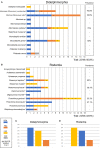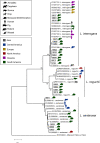Small Mammals as Carriers/Hosts of Leptospira spp. in the Western Amazon Forest
- PMID: 33344523
- PMCID: PMC7738340
- DOI: 10.3389/fvets.2020.569004
Small Mammals as Carriers/Hosts of Leptospira spp. in the Western Amazon Forest
Abstract
Leptospira is a bacteria that causes leptospirosis and is transmitted through water, soil, or mud that is contaminated by the urine of infected animals. Although it is mainly associated with the urban environment, Leptospires also circulate in rural and wild environments. This study aimed to investigate the role of small mammals in leptospirosis epidemiology in the western Amazon, Brazil. In total, 103 animals from 23 species belonging to the orders Didelphimorphia and Rodentia were captured. Blood, kidney, and urine samples were collected and Microscopic Agglutination Test (MAT), lipL32 PCR, secY sequencing, and culturing were conducted. MAT was reactive on 1/15 sera, and no bacterial isolate was obtained. PCR yielded 44.7% positive samples from 16 species. Twenty samples were genetically characterized and identified as L. interrogans (n = 12), L. noguchii (n = 4), and L. santarosai (n = 4). No statistical association was found between the prevalence of infection by Leptospira spp. in small mammals within carrier/hosts species, orders, study area, and forest strata. Our results indicate a high prevalence of pathogenic Leptospira spp. in several rodent and marsupial species and report the first evidence of Leptospira spp. carrier/hosts in the Brazilian Western Amazon.
Keywords: Amazon; marsupial; small mammal; sylvatic leptospirosis; wild rodent.
Copyright © 2020 Medeiros, Braga Domingos, Azevedo, Peruquetti, de Albuquerque, D'Andrea, Botelho, Crisóstomo, Vieira, Martins, Teixeira, Carvalho-Costa and Lilenbaum.
Conflict of interest statement
The authors declare that the research was conducted in the absence of any commercial or financial relationships that could be construed as a potential conflict of interest.
Figures



References
LinkOut - more resources
Full Text Sources
Miscellaneous

